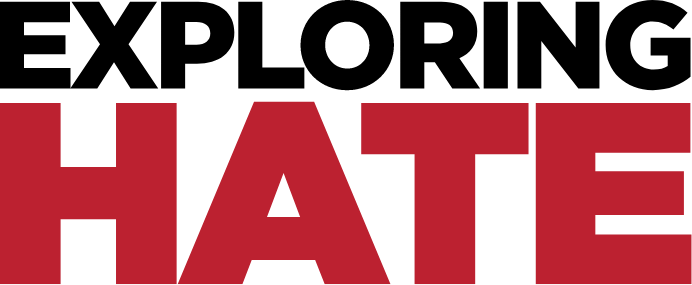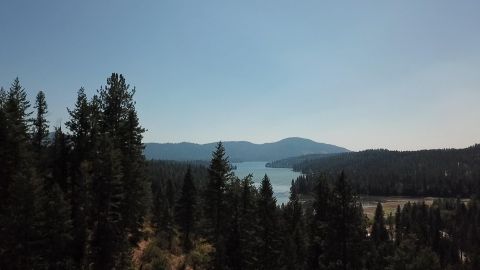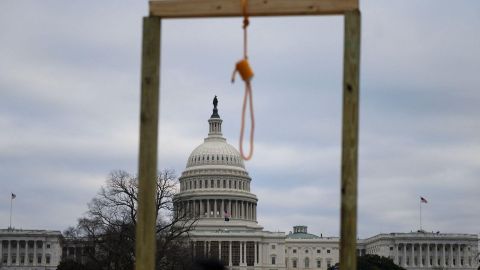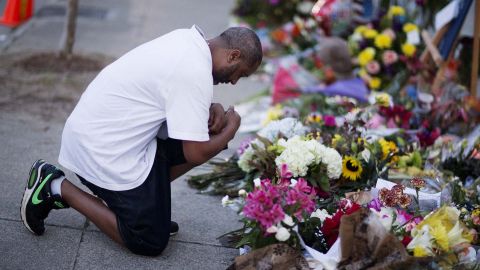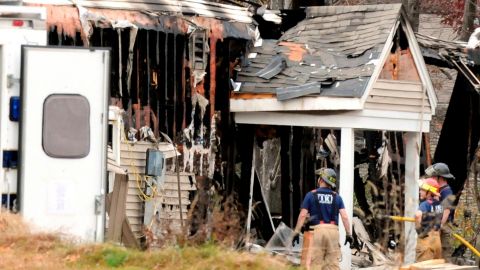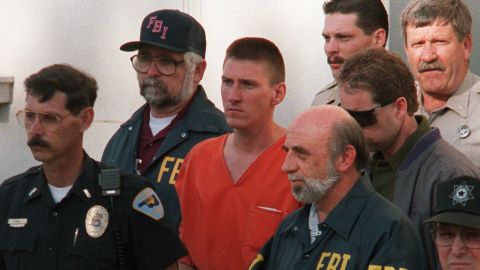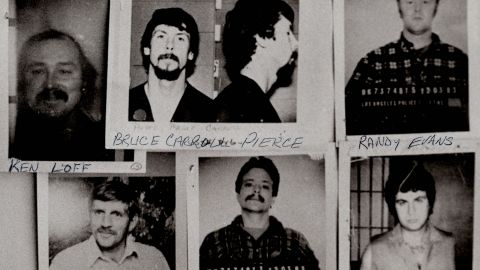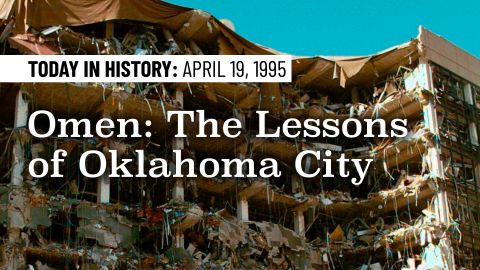ARCHIVAL A274 10/21/21
PRESIDENT JOE BIDEN: Domestic terrorism from white supremacists is the most lethal terrorist threat in the homeland.
MARK POTOK, Senior Fellow, Centre for Analysis of the Radical Right: Why is the radical right growing? Why are these ideas resurging in such a dramatic way?
TEXT ON SCREEN: Demonstrators: You will not replace us!
PETE SIMI, Assoc. Professor, Chapman University; Author, “American Swastika”: We’ve been unwilling to really grapple with our history. We have to understand where this problem has been in the past and what’s kept us from addressing it.
TEXT ON SCREEN: ARCHIVAL A088
RICHARD BUTLER, Aryan Nations: The white male is through in America.
DARYL JOHNSON, Former Senior Analyst, Department of Homeland Security: We saw the culmination of when far-right extremism goes unchecked. We have a much larger pool of people that could become potentially violent.
POTOK: The ideas, the propaganda of the radical right has moved into the political mainstream.
EXTREMISM IN AMERICA
OUT OF THE SHADOWS
KELVIN PIERCE: My father was Dr. William Pierce and he was the founder and the leader of the National Alliance, a white supremacist hate group, that he hoped would one day bring about the violent overthrow of the U.S. government. He was also the author of “The Turner Diaries,” the novel about an eventual race war. There have been numerous violent acts attributed to the book.
ARCHIVAL WILLIAM PIERCE: We catch people’s attention, give them information they wouldn’t have otherwise, and inspire them to do something about it.
ARCHIVAL CHARLOTTESVILLE A227-228, 133-136
[Chanting]
PIERCE: When I saw those people marching…
ARCHIVAL CHARLOTTESVILLE A227-228, 133-136
TEXT ON SCREEN: Demonstrators: You will not replace us!
PIERCE …it was like I was transported back to my childhood, in an instant.
TEXT ON SCREEN: Marchers: Blood and soil!
Text ON SCREEN: AUGUST 11, 2017
THOMAS O’CONNOR, Former Special Agent, F.B.I.: Hundreds of white males, mostly males, college age, showed up at Charlottesville chanting these anti-Semitic, white power movement chants. “Fire up the ovens, boys.” And “Jews will not replace us.” For those of us who work domestic extremism, that was really kind of the shot heard around the world.
ARCHIVAL Charlottesville
TEXT ON SCREEN: Demonstrators: Jews will not replace us!
The rally, which brought together white nationalists, neo-Nazis and others, brought hate out in the open.
SIMI: The Unite the Right rally was the largest public rally for white supremacists in more than a decade. And it turned out to be very violent.
Clashes between white nationalists and Antifa and other counter-protestors culminated when a neo-Nazi slammed his car into the crowd, injuring more than two dozen people and killing 32-year-old Heather Heyer.
SIMI: The car attack that takes Heather Heyer’s life was a show of strength for them.
SEN. DICK DURBIN (Democrat-Illinois): Many of these groups that used to hide in the shadows come out now and boldly march in the state of Virginia and other places. They feel somehow licensed and emboldened to do it. It’s more public now.
ARCHIVAL A450
DAVID DUKE, FORMER GRAND WIZARD, KU KLUX KLAN: We are determined to take our country back. We’re going to fulfill the promises of Donald Trump.
The march came seven months after Donald Trump took office, and his response became one of the defining moments of his presidency.
ARCHIVAL CBS NEWS A449
President DONALD TRUMP: You had a group on one side that was bad, and you had a group on the other side that was also very violent, and nobody wants to say that, but I’ll say it right now.
O’CONNOR: I’ve talked to people within the movement that clearly believed that the president’s statements were a statement of support.
ARCHIVAL CBS A449
TRUMP: And you had some very bad people in that group, but you also had people that were very fine people on both sides.
After the president’s statements, the extremism issue became politicized, according to Brian Murphy, a former Homeland Security official. He says he was told to change intelligence reports to downplay the white supremacist threat, something the Trump administration denied.
BRIAN MURPHY, Former Counterterrorism Official: If it touched on Charlottesville, it was looked at through a political lens. As time moved forward and the elections got closer, that changed more and more to be almost exclusively, uh, you know, we’re not going to talk about this because it will make the president look bad.
After the marches, Kelvin Pierce decided to go public with the story of how he rejected his father’s beliefs. And in the years since, he watched as white supremacist and other extremist violence has risen to the highest levels in decades.
KELVIN PIERCE: I think my father would’ve absolutely delighted in what’s happening in the country and the fact that racism really bubbled up to the surface.
At the same time, anti-government and other extremist groups have become more public, joining protests against pandemic lockdowns in 2020…
ARCHIVAL SOUNDUP MICHIGAN PROTEST
TEXT ON SCREEN: Treason! Treason!
… and fighting openly with racial justice protesters.
O’CONNOR: The burning and riots across the United States in 2020 were a catalyst to bring more people into the Oath Keepers, militia, Proud Boys.
Text on Screen: F**k Antifa!
MURPHY: Particularly after George Floyd was killed, that’s where a lot of these groups really started to coalesce, organize.
O’CONNOR: Instead of tamping that down, really gasoline was poured onto it with the rhetoric of the “stop the steal.”
On January 6th, members of extremist groups joined protests at the U.S. Capitol against what they called a stolen election.
ARCHIVAL A368 TRUMP: We fight like hell. And if you don’t fight like hell, you’re not going to have a country anymore.
And while most people that day were not connected to any extremist organization, members of the Oath Keepers, Proud Boys and other groups were on the frontlines of the attack and have been accused of helping plan it.
MURPHY: These things are all coalescing together into the perfect storm. Polarization on the right and the left, conspiracy theories, the idea that the election was rigged and stolen. It was really a new kind of conglomeration of things.
O’CONNOR: People built a gallows on the front lawn of the Capitol saying that they wanted to hang Mike Pence, the Republican vice president.
TEXT ON SCREEN: Demonstrators: Hang Mike Pence! Hang Mike Pence!
KELVIN PIERCE: When I saw that gallows, to me, you know, reminded me of the “Day of the Rope,” a chapter in the book where they really talk about grabbing everybody that had anything to do with a threat to the white race and hanging them.
Hundreds of people have been arrested in connection with January 6th. In June 2021, the federal government issued the first national strategy to combat domestic terrorism. But officials acknowledge it will be a challenge.
POTOK: We’ve seen this movement grow from a fringe phenomenon that involved a few thousand people around the country, disconnected, weak, with no political pull. We are in a different place now.
O’CONNOR: Pieces of rhetoric that have been spewed to the extremes, now that information permeates much more mainstream conversations.
SIMI: The organization names may change. The leaders come and go. But there’s a constancy in terms of the emotions and the beliefs that are driving this movement. That tells us how deep the problem is.
That’s why those who study the movement say it will take more than law enforcement to fight against it. For Kelvin Pierce, it took leaving home and being exposed to new ideas and people to reject his father’s beliefs.
PIERCE: You’re not born with hate in your heart. It’s taught to you. The lesson is from the healing that I’ve been able to experience. And I think that if I can do that, then I think other people can do it.
BILL MORLIN, Journalist (1946-2021): It takes these events to sort of jolt the American conscience awake.
ARCHIVAL:
TEXT ON SCREEN: RICHARD BUTLER Hate is our law.
MORLIN: There were a lot of people in the ’80s…
Text on screen: Protestors: What do we need? White power!
MORLIN: …and in the ’90s that, you know, said domestic terrorism is an important issue. People have been ringing the bell. Nobody’s been listening to the bell being rung. Having lived and covered a lot of these stories as a journalist, I’m certainly glad to hear that they’re now saying domestic terrorism is the real deal. And I certainly say it’s about time.
